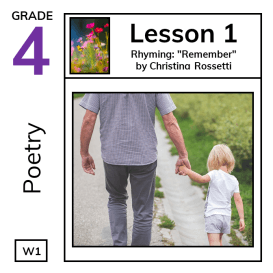
By: Christina Rossetti
Week: 1
During this school year, we'll study nine common literary devices. Literary devices are 'identifiable rules of thumb, convention, or structure that are employed in literature and storytelling.' Over the next four weeks, lessons focus on the literary device of rhyming. Rhyming is defined as a 'word that is pronounced identically with another word from the vowel in its stressed syllable to the end.' The featured poem, Christina Rossetti's 'Remember,' employs rhyming for effect. Through the title, the narrator asks the reader to remember something - and we wonder what? The poem reveals that the narrator fears dying and leaving their loved one. The first eight lines plead with the reader not to forget. The remaining lines comfort the reader, asking that if the reader temporarily forgets and then remembers, not to feel guilty, but to be happy. The narrator expresses trepidation over where our spirits venture after death - referring to the 'silent land' and 'darkness and corruption.'
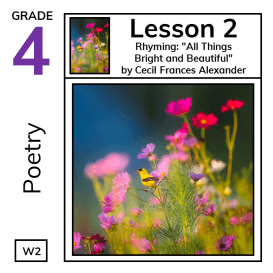
By: Cecil Frances Alexander
Week: 2
'All Things Bright and Beautiful' is a Christian hymn written in 1848 by Cecil Frances Alexander. The poetic text has been set to different melodies over the years. The text praises the Christian God for the brightness and beauty of the world, including flowers, birds, people from all walks of life, mountains, rivers, and trees. The text employs rhyming as a poetic device for effect.
By: Paul Laurence Dunbar
Week: 3
Paul Laurence Dunbar's 'Christmas Carol' celebrates Christmas and the birth of Jesus Christ. The poem employs the literary device of rhyming.
By: Paul Laurence Dunbar
Week: 4
In 'Merry Autumn', Paul Laurence Dunbar scolds those that mourn autumn and the 'dying of the year.' Dunbar argues that autumn is a glorious time of reds and yellows, of singing birds, sunshine, and fun. Dunbar sees autumn as the very best of the seasons and the 'climax of the year.'
By: Carolyn Wells
Week: 5
'The Butter Betty Bought' by Carolyn Wells plays with alliteration to create a fun tongue twister. Poor Betty has bitter butter that will blemish her batter. She runs out to pick up some preferable butter to make her batter better.
By: Alaric Alexander Watts
Week: 6
Alaric Alexander Watts takes alliteration to the extreme in his poem, 'The Siege of Belgrade.' Each line corresponds to one letter in the alphabet, with the letter 'A' repeating at the end. The poem describes the 1789 siege in which the Austrian army besieged a Turkish force sheltering within the fortress of Belgrade in modern-day Serbia. After three weeks, the Turkish forces surrendered. Today, Belgrade is the capital of Serbia.
By: Lord Alfred Tennyson
Week: 7
Lord Alfred Tennyson's 'The Eagle' sprinkles alliteration throughout the poem for effect. The poem details a lone eagle surveying the land and sea from his craggy perch. The eagle launches himself and rockets down from his mountaintop.
By: Gerard Manley Hopkins
Week: 8
In Gerard Manley Hopkins' 'Pied Beauty,' he praises the Christian God for multicolored (pied) things, including the sky, cows, chestnuts, trout, finches, and farmland. He also thanks God for freckled things not typically thought of as beautiful - the odd and the strange.
By: Clement Clarke Moore
Week: 9
The beloved classic, 'A Visit from St Nicholas,' by Clement Clarke Moore is read in many American homes on Christmas Eve. In the poem, the father of the family is awakened by the arrival of Santa Claus and his reindeer. The father watches as Santa Claus comes down the chimney and marvels at Santa's jolly features and demeanor. Santa Claus fills the stockings, vanishes back up the chimney, and calls out 'Happy Christmas to all, and to all a good-night' as his sleigh soars through the air. The poem contains multiple similes, particularly while describing Santa Claus.
By: Amy Lowell
Week: 10
The young narrator in Amy Lowell's 'A Lady,' employs similes to describe their fascination with the faded beauty of an older woman. The narrator entertains the older woman with their active and youthful behavior.
By: William Wordsworth
Week: 11
William Wordsworth's poem, 'I Wandered Lonely as a Cloud,' describes the narrator finding a field of daffodils along a lake shore. At this time, he does not yet realize the worth of this encounter. Long after he's left the scene, when he's lonely or restless, the recollection of the daffodils makes him happy.
By: Robert Frost
Week: 12
In Robert Frost's poem, 'Birches,' the swaying of the birches in the wind reminds the narrator of climbing birch trees during their childhood. The narrator recalls how ice storms may temporarily or even permanently bend the birch trees, but do not break them. The narrator longs to leave earth and to return as a boy again so he can once again be a swinger of birches. The poem makes use of similes for dramatic effect.
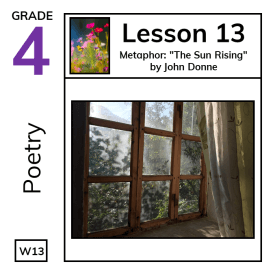
By: John Donne
Week: 13
In John Donne's 'The Sun Rising,' the narrator scolds the sun for waking him, for he prefers remaining cocooned with his true love. The narrator refuses to close his eyes to block the sun because he'd lose sight of his true love. The rest of the world does not matter to the narrator, whether king or prince or wealth or expensive spices. All that matters is his true love. The narrator considers their bedroom the center of his universe. In this poem, Donne employs a literary device called a metaphor. A metaphor uses a word or phrase to refer to something that it is not to make an implied comparison.
By: William Shakespeare
Week: 14
William Shakespeare's 'Shall I Compare Thee to a Summer's Day,' is an extended metaphor, comparing the narrator's true love to a summer's day and finding the summer's day lacking. The narrator consoles his beloved that she will live forever through his poem.
By: John Keats
Week: 15
In John Keats' stark and ponderous poem, 'When I have Fears That I May Cease to Be,' the narrator discusses his fears of not fully realizing his potential in life. He worries he will not write enough books. He worries he won't meet his fated true love. But when he ponders the universe, he realizes that in the big picture, fame and love may be meaningless.
By: Paul Laurence Dunbar
Week: 16
Paul Laurence Dunbar's heart-wrenching poem, 'Sympathy,' is an extended metaphor, comparing oppressed people (e.g. minorities in an oppressive society) to a bird trapped in a cage. The bird longs for the beautiful breezes and sunlight of freedom so keenly, it bloodies its beating wings while trying to escape the cage. The bird sings not with happiness, but to pray to heaven for mercy.
By: Robert Frost
Week: 17
'Stopping by Woods on a Snowy Evening' by Robert Frost personifies a horse. The horse thinks things are strange and shakes its harness to ask whether a mistake has been made when the narrator stops in the middle of the dark woods. The narrator thinks he knows who owns the property he's stopped upon. However, the owner lives in town and will never know he stopped there. The narrator knows he must get going. He has miles to go before he reaches his destination.
By: Emily Dickinson
Week: 18
Emily Dickinson's charming 'She Sweeps with Many-Colored Brooms,' personifies the sun. Dickinson compares the setting sun with a housewife who sweeps her house at the end of the day. The rays of light are compared to the broom, which leaves behind fragments, or the colors of the sunset. The housewife's white apron represents the flying clouds. The broom and its colorful fragments slowly fade away into stars as night approaches.
By: Robert Frost
Week: 19
In Robert Frost's 'Mowing,' the narrator cuts hay and imagines his scythe is whispering secret messages to the ground. He ponders what the scythe is saying - perhaps something about the hot sun or the quiet. He doesn't think the scythe dreams of lazing about or easy riches. Rather, the reality of its simple work is enough for the scythe, whether its cutting rows of hay or scaring green snakes.
By: Emily Dickinson
Week: 20
Emily Dickinson's 'The Railway Train' personifies a train (the train superciliously peers at shanties and complains). The poem can also be seen as an extended metaphor, comparing the train to a horse or other animals. The animalistic train laps up miles, licks up valleys, feeds at fuel tanks, crawls, and neighs.
By: Sara Teasdale
Week: 21
Sara Teasdale's 'Spring Rain' uses both flashbacks and foreshadowing for effect. A spring thunderstorm causes the narrator to flash back to a time when she waited out a storm in a doorway with another person. Little details, such as the passing busses and the light shining on the water, have stuck in the narrator's memory. The narrator gazed into the other person's eyes as her heart pounded, hinting at romance. The two exchanged looks surpassing the significance of any of their future conversations, foreshadowing the moment's importance in the narrator's future life.
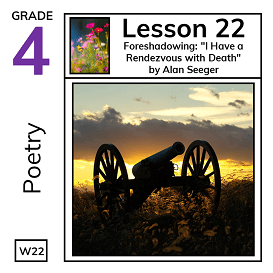
By: Alan Seeger
Week: 22
Moved by idealism, American Alan Seeger volunteered to fight in World War I for the Foreign Legion of France. America had not yet entered the war. Seeger's poem, 'I Have a Rendezvous with Death,' foreshadows his death in battle. He imagines dying during the following spring on a battle-scarred hill in a burning town at midnight. Seeger's predictions partly came true. He died at the young age of 28 on the 4th of July while fighting in World War I. While Seeger was dying, others reported that he cheered on his fellow soldiers to the very end.
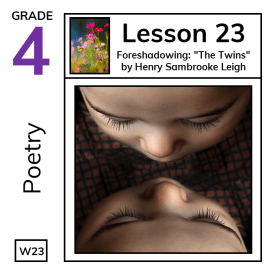
By: Henry Sambrooke Leigh
Week: 23
In Henry Sambrooke Leigh's 'The Twins,' the narrator is confused with his identical twin, John, throughout his life. The confusion leads to negative and absurd consequences including being punished for his brother's misdeeds, his brother marrying the narrator's intended bride, and his brother being buried when the narrator died. In the poem, phrases such as 'It reached a fearful pitch' foreshadows the trouble the narrator and his brother will suffer from the twin-related mix-ups.
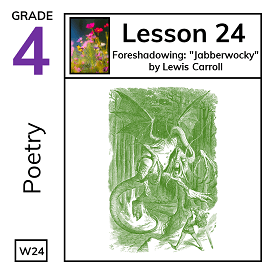
By: Lewis Carroll
Week: 24
Don't worry if you don't recognize the words in Lewis Carroll's nonsense poem, 'Jabberwocky.' Many of the words are made up (see the translation below the original poem in the lesson). In the poem, a father warns his son about the fiery-eyed, clawing, biting Jabberwock. The son ignores his father's advice, grabs his sword, and ventures out. After the son kills the Jabberwock, he brings the head back to his father. His father is very proud, and all returns to normal. With the father's warning, the poem employs foreshadowing to hint at the upcoming battle.
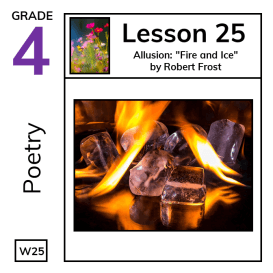
By: Robert Frost
Week: 25
In 'Fire and Ice,' Robert Frost ponders whether fire or ice will bring about the end of the world. He remarks that either will do, but he believes fire will win out. Frost makes what some see as an allusion to the Christian Bible in the poem. 'Some say the world will end in fire,' can be linked to Peter 3:7, which states, 'the present heavens and earth are reserved for fire, being kept for the day of judgment.' In the Bible, the day of judgement is the final trial of all humankind, when each is rewarded or punished according to his or her merits. Frost makes a second scientific allusion that the world may end in ice, perhaps due to our ever-expanding universe. An alternative interpretation of the poem advocates that fire stands for desire and ice for hatred. Either too much desire or too much hatred could potentially bring about the end of humanity via means such as nuclear warfare.
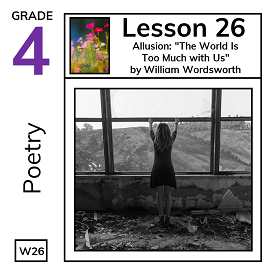
By: William Wordsworth
Week: 26
William Wordsworth wrote 'The World Is Too Much with Us' around 1802, in the midst of the First Industrial Revolution (circa 1760-1840). The first eight lines of the poem discuss problems caused by the Industrial Revolution, and the final six lines address the solution. Wordsworth criticizes humankind's elevation of consumerism and rejection of nature. He remarks he'd rather live in a Pagan, nature-worshipping world than a world full of greed and destruction of nature. Wordsworth alludes to figures in Greek mythology, including Proteus, a sea-god, and Triton, the messenger of the sea.
By: Christina Rossetti
Week: 27
Christina Rossetti's 'Christmas Day' alludes to the Biblical birth, life, crucifixion, and death of Jesus Christ. Rossetti employs multiple metaphors, comparing Jesus Christ to a lamb, a rose, and a lily. Rossetti also uses rhyming for effect.
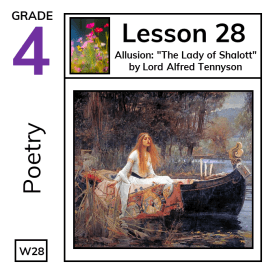
By: Lord Alfred Tennyson
Week: 28
Lord Alfred Tennyson's poem, 'The Lady of Shalott,' alludes to the medieval mythological tales of King Arthur and his castle and court of Camelot. In Arthurian legend, a woman named Elaine is smitten with Sir Lancelot, one of King Arthur's Knights of the Round Table. When Elaine confesses her love, Sir Lancelot rejects her. Dying from a broken heart, Elaine instructs her father to float her body on a river barge to Camelot. When her body arrives, Sir Lancelot is grieved. However, he does not regret refusing Elaine's advances because he does not love her. Although featuring similar characters, the poem differs from the traditional tale. In the poem version, 'The Lady of Shalott' is imprisoned on the Isle of Shalott, which sits in the midst of a river flowing to Camelot. The Lady of Shalott is forced to spin a magic web and will be cursed if she looks at Camelot. She can only view shadowy reflections of Camelot and its people through a magical mirror. One day, the Lady of Shalott spots Sir Lancelot floating by on the river. She falls so deeply in love with him that she looks at Camelot and is cursed. Knowing she is cursed, she lies in a barge and floats down the river to Camelot. By the time she reaches Camelot, she's perished from the cold. Sir Lancelot sees her and remarks, 'She has a lovely face; God in his mercy lend her grace, The Lady of Shalott.'
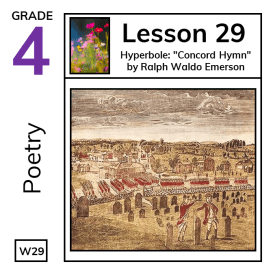
By: Ralph Waldo Emerson
Week: 29
Ralph Waldo Emerson's poem, 'Concord Hymn,' alludes to the first shot fired in the Revolutionary War by an American militiaman at the British troops in Concord, Massachusetts. The first shot occurred in April, as referred to in the poem. Emerson employs hyperbole when he calls the first shot, 'The Shot Heard Round the World.' Obviously, not everyone in the world heard it. However, the Revolutionary War has had a world-wide impact, changing the trajectory of world events since that time.
By: Robert Burns
Week: 30
'A Red, Red Rose' by Robert Burns incorporates hyperbole to express the narrator's love for his 'bonnie lass.' He will love her until the seas go dry and the rocks melt in the sun. The end of the poem reveals the narrator must part from his love, but assures the reader that he'd travel ten thousand miles for their reunion.
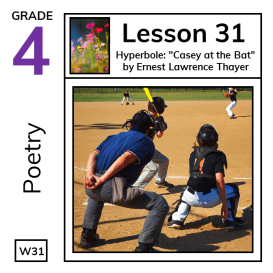
By: Ernest Lawrence Thayer
Week: 31
'Casey at the Bat: A Ballad of the Republic Sung in 1888' by Ernest Lawrence Thayer describes the home baseball team of Mudville in a desperate situation. It's the final inning, and Mudville must score or lose the game. Mudville is currently down, six to four. Two batters have struck out, one is on second base, and another is on third base. Luckily for the Mudville team, Casey, the team's superstar, is up to bat. Casey lets the first two pitches go by without swinging, racking up two strikes. One more strike, and Mudville will lose the game. Will Casey knock it out of the park? Will Casey strike out? The poem reveals the answer.
By: Emily Dickinson
Week: 32
Emily Dickinson's 'For Each Ecstatic Instant' uses hyperbole to express the grief of the narrator, describing 'coffers heaped with tears.' (How much would you have to cry to fill up a box?) The poem expresses that in life, we must pay in pain to purchase our joys.
By: Edgar Allan Poe
Week: 33
Edgar Allan Poe sprinkles Onomatopoetic terms liberally through his poem, 'The Bells.' Poe describes in detail the joyous, celebratory, panicked, and sorrowful ringing of different types of bells. Poe first describes the joyful tinkling and jingling of sleigh bells, second, the equally happy but mellow ringing and chiming of wedding bells, third, the clanging and shrieking of alarm bells, and finally, the mournful moaning and groaning of iron bells.
By: Robert Browning
Week: 34
In 'Meeting at Night,' Robert Browning immerses the reader in the narrator's journey under a moonlit sky. The narrator rows in a boat, hikes over a sandy beach, and crosses three fields to arrive at a farm for a joyous reunion with a loved one. The poem uses Onomatopoeia in describing the narrator's tap at the pane, the scratch of a match, and the spurt of a flame.
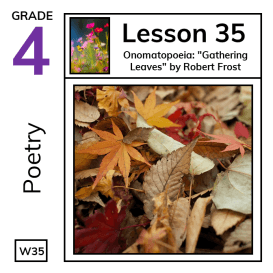
By: Robert Frost
Week: 35
'Gathering Leaves' by Robert Frost philosophizes about the cyclical nature of life. In the poem, the narrator describes the tedious process of raking up, bagging, and hauling off mountains of leaves. The narrator complains that spades are no better than tiny spoons for scooping up leaves, and gripes that when he scoops up the leaves with his arms, many overflow to escape back the ground. He forces the mountains of leaves into bags, which are as light and inconsequential as balloons, belying the hard work taken to fill them. Even more dispiriting, the leaves he's painstakingly bagging up are worthless. The narrator reminds himself that removing the leaves is an essential part of fall harvest time that will allow other plants to flourish in the following spring and summer. The tired narrator wonders whether the continual cycle of trees growing and losing their leaves every year will ever stop.
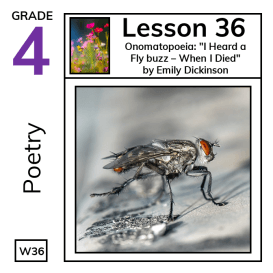
By: Emily Dickinson
Week: 36
In Emily Dickinson's 'I heard a Fly buzz – when I died,' the narrator reflects on her death from beyond the grave. The room is silent. The onlookers are so exhausted from the strain of watching a loved one die, they can no longer cry. The narrator has just signed away her worldly possessions and the King (Death) is coming for her, when the fly arrives. The fly breaks the silence with its buzz and blocks the narrator's light just before she dies, plunging her into blackness. The buzz of a fly is usually unmemorable and insignificant. However, in the poem, the buzz momentously marks the moment of the narrator's death.